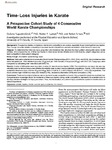Mostrar o rexistro simple do ítem
Time-loss injuries in karate: a prospective cohort study of 4 consecutive world karate championships
| dc.contributor.author | Augustovicova, Dusana | |
| dc.contributor.author | Lystad, Reidar P. | |
| dc.contributor.author | Arriaza, Rafael | |
| dc.date.accessioned | 2019-10-11T17:29:52Z | |
| dc.date.available | 2019-10-11T17:29:52Z | |
| dc.date.issued | 2019 | |
| dc.identifier.issn | 2325-9671 | |
| dc.identifier.uri | http://hdl.handle.net/2183/24097 | |
| dc.description.abstract | [Abstract]: Background: Prospective studies on injuries in martial arts competitions are scarce, especially those involving time-loss injuries. The upsurge of karate athletes competing in top-level karate competitions warrants elucidation of the time-loss injury risk. Purpose: To determine the time-loss injury proportion and incidence rate, describe the injury pattern among elite senior karate athletes, and compare the risk of time-loss injuries in male versus female athletes and in individual (ie, weight categories) versus team competitions (free-weight category). Study Design: Descriptive epidemiology study. Methods: Data were collected at 4 consecutive World Karate Championships (2010, 2012, 2014, and 2016). Injury incidence rates were calculated per 1000 athlete-exposures (IIRAE) and per 1000 minutes of exposure (IIRME), with 95% CIs. Subgroups were compared by calculating their rate ratios with 95% CIs. Results: A total of 506 injuries were recorded, of which 51 were time-loss injuries (10%). The overall time-loss injury rate was significantly lower for female versus male athletes and slightly lower for team versus individual competitions. Overall, 1.4%of all athletes sustained a time-loss injury, and the IIRAE and IIRME were 5.13 (95% CI, 3.82-6.74) and 1.98 (95% CI, 1.47-2.60), respectively. The most common type of time-loss injury was fracture (41%), followed by dislocation (20%) and concussion (12%). Conclusion: The time-loss injury incidence rate for top-level karate competitions found in this prospective study was relatively low. Comprehensive knowledge about the incidence of time-loss injuries during karate competitions represents an essential basis to develop effective strategies for injury prevention. Thus, the introduction of a uniform injury surveillance system in martial arts is of utmost importance. | es_ES |
| dc.language.iso | eng | es_ES |
| dc.publisher | SAGE PUBLICATIONS INC | es_ES |
| dc.relation.uri | https://doi.org/10.1177%2F2325967119865866 | es_ES |
| dc.rights | Atribución-NoComercial-SinDerivadas 4.0 España | es_ES |
| dc.rights.uri | http://creativecommons.org/licenses/by-nc-nd/4.0/es/ | * |
| dc.subject | Athletic injuries | es_ES |
| dc.subject | Karate | es_ES |
| dc.subject | Combat sport | es_ES |
| dc.subject | Incidence | es_ES |
| dc.subject | Risk factors | es_ES |
| dc.subject | Lesiones atléticas | es_ES |
| dc.subject | Deporte de combate | es_ES |
| dc.subject | Factores de riesgo | es_ES |
| dc.subject | Incidencia | es_ES |
| dc.title | Time-loss injuries in karate: a prospective cohort study of 4 consecutive world karate championships | es_ES |
| dc.type | info:eu-repo/semantics/article | es_ES |
| dc.rights.access | info:eu-repo/semantics/openAccess | es_ES |
| UDC.journalTitle | Orthopaedic journal of sports medicine | es_ES |
| UDC.volume | 7 | es_ES |
| UDC.issue | 8 | es_ES |
| UDC.startPage | 1 | es_ES |
| UDC.endPage | 6 | es_ES |
Ficheiros no ítem
Este ítem aparece na(s) seguinte(s) colección(s)
-
GI-INCIDE - Artigos [17]






